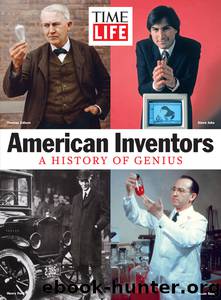TIME-LIFE American Inventors by The Editors of TIME-LIFE

Author:The Editors of TIME-LIFE
Language: eng
Format: epub
Publisher: Liberty Street
Published: 2015-07-24T20:30:00+00:00
From its simple beginnings with handkerchiefs and ribbon, the brassiere has developed into an item with $15 billion annual global sales.
CARESSE CROSBY, DISTANTLY RELATED TO ROBERT FULTON, ONCE REMARKED SHE INHERITED HER TALENT FROM HIM. “I CAN’T SAY THAT THE BRASSIERE WILL EVER TAKE AS GREAT A PLACE IN HISTORY AS THE STEAMBOAT, BUT I DID INVENT IT.”
Both Sides Now
LLOYD COPEMAN
(1881–1956)
Two-sided toaster, rubber ice cube tray, and more
Lloyd Copeman had nearly 700 patents to his name.
Inventor Lloyd Copeman caught the tinkering bug early. At age 10, he rigged up a machine that could turn a grindstone automatically. For the bathroom in his schoolhouse in Farmers Creek, Michigan, he is said to have designed a remote-controlled paddle that could whack an unsuspecting visitor. Over the course of his lifetime, Copeman would amass some seven hundred patents.
Toasts of the Times
The practice of toasting bread, whether in a pan or on a stick, dates to Roman times. But with the advent of electricity in the early 20th century, inventors began experimenting with more efficient means.
In 1909 the first electric toaster was produced by Frank Shailor of General Electric. He created a heating element that could hold a high temperature without breaking. The problem with Shailor’s toaster was that it only toasted one side of the bread at a time. The bread had to be turned by hand—a dangerous task in the early days of electrical wires, which would sometimes get so hot that they would burst into flames.
Turning Point
It was Copeman’s wife, Hazel, who gave him the idea for a two-sided toaster after happening upon a window display of the one-sided variety. Hazel wondered aloud whether a device could be built that would automatically turn the toast. Copeman went to work to design such a machine.
Copeman patented his invention in 1914, and his company, the Copeman Electric Stove Company, began manufacturing them. They were much safer than previous models and marketed as the “toaster that turns toast.” Westinghouse Electric purchased Copeman’s company in 1918 and continued to make the appliances.
Freezing Out the Competition
Copeman patented several other inventions, including a clothesline for hotel rooms (the “Flexo-Line”) and his most lucrative, the rubber ice cube tray. The idea for the tray came to him as he was walking in the woods one winter day and noticed that slush and ice did not stick to his rubber boots. The tray inspiration earned him the equivalent of $10 million in today’s dollars. Copeman died in 1956, but his creativity lives on through his granddaughter, the singer Linda Ronstadt, a 12-time Grammy Award winner who has sold 100 million albums.
Download
This site does not store any files on its server. We only index and link to content provided by other sites. Please contact the content providers to delete copyright contents if any and email us, we'll remove relevant links or contents immediately.
Learning SQL by Alan Beaulieu(6209)
Weapons of Math Destruction by Cathy O'Neil(6142)
Digital Minimalism by Cal Newport;(5662)
iGen by Jean M. Twenge(5366)
Sapiens by Yuval Noah Harari(5293)
The Age of Surveillance Capitalism by Shoshana Zuboff(4209)
Elon Musk by Ashlee Vance(4027)
Thing Explainer by Randall Munroe(3876)
Apollo 8 by Jeffrey Kluger(3635)
Future Crimes by Marc Goodman(3528)
The Science Book (Big Ideas Simply Explained) by DK(3233)
Who Can You Trust? by Rachel Botsman(3086)
Infinite Energy Technologies by Finley Eversole(2938)
I Live in the Future & Here's How It Works by Nick Bilton(2934)
Steve Jobs by Walter Isaacson(2830)
The Innovators: How a Group of Hackers, Geniuses, and Geeks Created the Digital Revolution by Walter Isaacson(2827)
Dawn of the New Everything by Jaron Lanier(2737)
Chernobyl by Serhii Plokhy(2496)
Ben Franklin's Almanac by Candace Fleming(2464)
